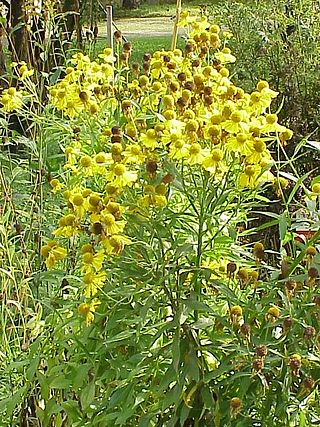
Allium canadense, the Canada onion, Canadian garlic, wild garlic, meadow garlic and wild onion is a perennial plant native to eastern North America from Texas to Florida to New Brunswick to Montana. The species is also cultivated in other regions as an ornamental and as a garden culinary herb. The plant is also reportedly naturalized in Cuba.

Bouteloua curtipendula, commonly known as sideoats grama, is a perennial, short prairie grass that is native throughout the temperate and tropical Western Hemisphere, from Canada south to Argentina.

Grindelia squarrosa, also known as a curly-top gumweed or curlycup gumweed, is a small North American biennial or short-lived perennial plant.

Calopogon tuberosus, the tuberous grass pink, is an orchid native to eastern North America.

Liatris aspera is a perennial wildflower in the Asteraceae family that is found in central to eastern North America in habitats that range from mesic to dry prairie and dry savanna.

Houstonia caerulea, commonly known as azure bluet, Quaker ladies, or bluets, is a perennial species in the family Rubiaceae. It is native to eastern Canada and the eastern United States. It is found in a variety of habitats such as cliffs, alpine zones, forests, meadows and shores of rivers or lakes.

Liatris pycnostachya, the prairie blazing star, cattail gayfeather or cattail blazing star, is a perennial plant in the Asteraceae family that is native to the tallgrass prairies of the central United States.

Helenium autumnale is a North American species of flowering plants in the family Asteraceae. Common names include common sneezeweed and large-flowered sneezeweed.

Rosa carolina, commonly known as the Carolina rose, pasture rose, or prairie rose, is a perennial shrub in the rose family native to eastern North America. It can be found in nearly all US states and Canadian provinces east of the Great Plains. It is common throughout its range and can be found in a wide variety of open habitats, from thickets and open woods to roadsides and along railroads.

Cirsium discolor, the field thistle, is a North American species of plants in the tribe Cardueae within the family Asteraceae. It is native to thirty-three states in the United States as well four Canadian provinces. It occurs across much of eastern and central Canada as well as eastern and central United States. It has been found from New Brunswick west to Saskatchewan and south as far as Texas and Georgia.
The North America Prairies is a large grassland floristic province within the North American Atlantic Region, a floristic region within the Holarctic Kingdom. It lies between the Appalachian Province and the Rocky Mountains and includes the prairies of the Great Plains. It is bounded by the Canadian coniferous forests on the north and the arid semideserts to the southwest. The province itself is occupied by temperate grasslands, savannas, and shrublands. Endemism is rather limited in this province, and its boundaries are vague. During the Pleistocene much of the province was glaciated.

Allium stellatum, commonly known as the autumn onion, prairie onion, cliff onion, or glade onion, is a North American species of wild onion in the Amaryllidaceae family that is native to central Canada and the central United States.

Oenothera macrocarpa, the bigfruit evening primrose, Ozark sundrops, Missouri evening primrose, or Missouri primrose, is a species of flowering plant in the evening primrose family Onagraceae, native to northeast Mexico and the south-central United States, where it is found in calcareous prairies and limestone outcrops.

Asclepias quadrifolia, commonly called four-leaved milkweed or fourleaf milkweed, is a species of milkweed in the Apocynaceae (dogbane) family. It is sometimes referred to as whorled milkweed, but it should not be confused with Asclepias verticillata. A. quadrifolia occurs in the eastern United States and Canada.

Desmodium illinoense, the Illinois ticktrefoil, is a flowering plant in the bean family (Fabaceae), native to the central United States and Ontario, Canada. Illinois ticktrefoil grows in sunny places, such as prairies and oak savannas of the Great Plains and Great Lakes regions.

Bradburia pilosa, the soft goldenaster, is a North American species of flowering plants in the family Asteraceae, native to the south-central United States, primarily the southeastern Great Plains and lower Mississippi Valley, in the states of Texas, Oklahoma, Kansas, Missouri, Arkansas, Louisiana, Tennessee, Mississippi, and Alabama. Additional populations are reported farther east but these appear to be introductions. Its habitats include disturbed roadsides and pine-oak-juniper woods.

Fleischmannia incarnata, the pink slender-thoroughwort or pink thoroughwort, is a North American species of flowering plant in the family Asteraceae. It is native to the United States from Florida north as far as Virginia, Ohio, and Illinois, and west to Texas and Oklahoma. It is also found in northeastern Mexico.
Phlox oklahomensis, the Oklahoma phlox, is a species of flowering plant in the family Polemoniaceae. It can be found in the prairies of Kansas, Oklahoma and Texas.

Asclepias hirtella, commonly called the tall green milkweed, is a species of flowering plant in the milkweed genus and dogbane family (Apocynaceae). It is native to Canada and the United States, where its range is concentrated in the Midwest and Upper South.

Dalea multiflora, commonly called roundhead prairie clover, is a species of flowering plant in the legume family (Fabaceae). It is native to North America, where it is found in Mexico and the United States. In the U.S., it is primarily found in the Great Plains and South Central regions. Its natural habitat is in dry rocky prairies, particularly in limestone soils. It is a conservative species and can be indicative of undisturbed prairie communities.



















